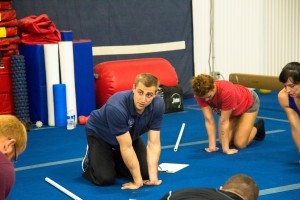Search results for:
A guide to mastering and progressing the GHR, Nordic ham curl, reverse hyper, and back extension. …read more
Are you matching your carb intake to your activity level, metabolic condition, and goal? You should be. …read more

Last week we went over the importance of implementing assessment and corrective strategies at your box. This week we’ll begin going over the specifics of how to do it. First up, overhead mobility. I love myself some overhead work. Most boxes also love themselves overhead work. Let’s just for a second make a list of common exercises you’re going to see at our gyms:
The list goes on and on. If we want to be any good at these exercises it makes absolute sense that we should have full overhead motion. If it’s hard for me to get my arms overhead without any weight, it also makes sense that putting 300lbs overhead is going to be tricky. It also makes some sense that people that are lacking motion here might be running into greater potential for injury in the future.
Missing overhead motion will also cause compensation down the chain such as poor scapular position, excessive rib motion and increased lumbar lordosis. All big words for what may lead to pain and inefficiency over time.
A good place to use this screen would be during your foundations / elements / on ramp classes where you’ll be doing a lot of overhead work. Like I alluded to earlier, most people come to your box because they want to work-out, not to be lectured in shoulder safety. However, explaining the importance of overhead motion for both efficiency in the movements shown today (and for most people you’ll be pointing out those deficits all throughout class) and exercise safety goes a long way in getting people to buy-in. If taught quickly and efficiently it also shouldn’t take away from the client’s experience. Most members end up …read more
Observe the laws. Build muscle, lose fat, and win the mind game. It starts right here. …read more
Whether your goal is to deadlift 400 or 700, two things are clear: you’ve got to bloody some shins and you’ve got to learn these cool training techniques. …read more
Forget icing and NSAIDS. They may delay or prevent healing. Instead, try these methodologies that you probably haven’t heard of. …read more
Use this simple math formula to find your perfect bench press grip, prevent injuries, and lift a lot more weight. …read more
Obsessed endurance athletes like triathloners need to pick up some heavy weights if they want to stay strong and injury-free. Here’s how. …read more
Spankin’ new studies about junk food, motivation, and diet psychology to help you get ripped and stay that way. …read more

I’ve been doing quite a bit of traveling and speaking around the United States lately and one of the biggest things I’m trying to do is educate people about screening and assessing themselves and their clients. It is enormously important and also enormously overlooked and forgotten in our realm. We’ve become very good with practicing technique, programming properly and spending time mobilizing. The issue is that we don’t really understand mobility. People come to me saying they’re mobilizing but they’re still in pain or they’re still limited with “X” or “Y” exercise. The first thing I’ll ask is if anyone ever evaluated them to see where the issue is coming from, or even if the individual even needs more flexibility work. Are you using the right exercises? Do you know how to tell if your exercises are making a difference?
Being able to assess our athletes will allow us to hone in on their specific deficits and efficiently correct these. It’s important to know the source of someone’s dysfunction because if we guess wrong we’re essentially spinning our wheels by applying an intervention that doesn’t get at the root cause of the problem. Also, if we apply a shotgun approach to mobility then we’re being incredibly inefficient. Mobility and corrective exercise is already not very sexy, no need to waste time working on things that don’t need to be worked on. We want to spend the bulk of our time training and mobility should be short, sweet and effective. However, we can’t ignore mobility as some experts will espouse. Not everything can be fixed by squatting more and some things can be made worse by this approach.
Think of it this way. Imagine someone who has poor overhead squat mechanics. This could be coming solely from a right ankle dorsiflexion limitation stemming from …read more


 Location: Östermalmsgatan 13
Location: Östermalmsgatan 13 Phone: +46 (0) 141-478830
Phone: +46 (0) 141-478830 Email:
Email: 




